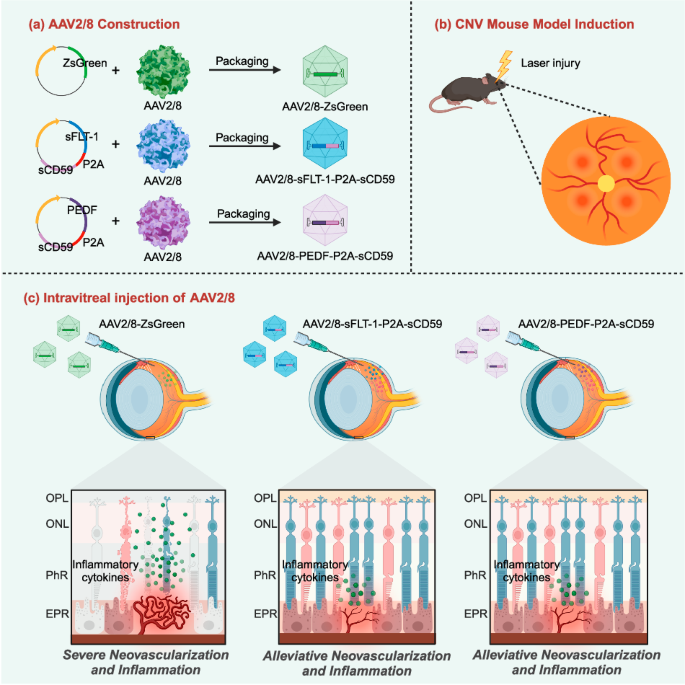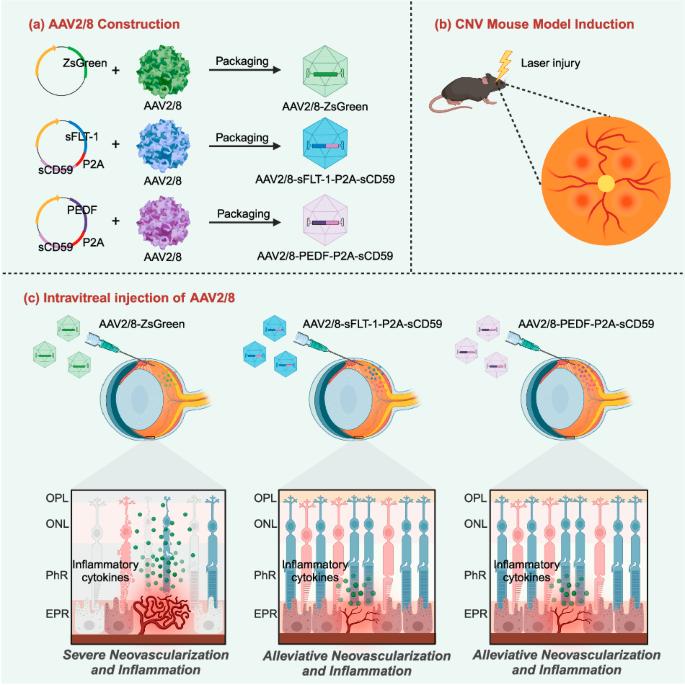腺相关病毒 2/8 接种双特异性分子对脉络膜新生血管的稳定抑制。
IF 4.6
3区 医学
Q1 BIOCHEMISTRY & MOLECULAR BIOLOGY
引用次数: 0
摘要
新生血管性老年性黄斑变性(nAMD)会导致严重的视力损伤。色素上皮衍生因子(PEDF)、可溶性 CD59(sCD59)和可溶性 fms 样酪氨酸激酶-1(sFLT-1)是治疗 nAMD 的潜在药物,它们针对血管生成和补体系统。利用AAV2/8载体生成了两种双靶点基因治疗药物:AAV2/8-PEDF-P2A-sCD59和AAV2/8-sFLT-1-P2A-sCD59,并在激光诱导的脉络膜新生血管(CNV)和Vldlr-/-小鼠模型中研究了它们的疗效。单次注射后,AAV2/8介导的基因表达在视网膜中的高水平维持了两个月。AAV2/8-PEDF-P2A-sCD59和AAV2/8-sFLT-1-P2A-sCD59都能在较长时间内显著减少CNV的发展,且无副作用,其疗效与目前的抗血管内皮生长因子单药注射两次相似。从机理上讲,这些药物抑制了细胞外信号调节激酶和核因子-κB通路,从而产生了抗血管生成活性。这项研究证明了AAV2/8-PEDF-P2A-sCD59和AAV2/8-sFLT-1-P2A-sCD59治疗CNV的安全性和持久性,为nAMD提供了一种前景广阔的治疗策略。本文章由计算机程序翻译,如有差异,请以英文原文为准。


Stable inhibition of choroidal neovascularization by adeno-associated virus 2/8-vectored bispecific molecules
Neovascular age-related macular degeneration (nAMD) causes severe visual impairment. Pigment epithelium-derived factor (PEDF), soluble CD59 (sCD59), and soluble fms-like tyrosine kinase-1 (sFLT-1) are potential therapeutic agents for nAMD, which target angiogenesis and the complement system. Using the AAV2/8 vector, two bi-target gene therapy agents, AAV2/8-PEDF-P2A-sCD59 and AAV2/8-sFLT-1-P2A-sCD59, were generated, and their therapeutic efficacy was investigated in laser-induced choroidal neovascularization (CNV) and Vldlr−/− mouse models. After a single injection, AAV2/8-mediated gene expression was maintained at high levels in the retina for two months. Both AAV2/8-PEDF-P2A-sCD59 and AAV2/8-sFLT-1-P2A-sCD59 significantly reduced CNV development for an extended period without side effects and provided efficacy similar to two injections of current anti-vascular endothelial growth factor monotherapy. Mechanistically, these agents suppressed the extracellular signal-regulated kinase and nuclear factor-κB pathways, resulting in anti-angiogenic activity. This study demonstrated the safety and long-lasting effects of AAV2/8-PEDF-P2A-sCD59 and AAV2/8-sFLT-1-P2A-sCD59 in CNV treatment, providing a promising therapeutic strategy for nAMD.
求助全文
通过发布文献求助,成功后即可免费获取论文全文。
去求助
来源期刊

Gene Therapy
医学-生化与分子生物学
CiteScore
9.70
自引率
2.00%
发文量
67
审稿时长
4-8 weeks
期刊介绍:
Gene Therapy covers both the research and clinical applications of novel therapeutic techniques based on a genetic component. Over the last few decades, significant advances in technologies ranging from identifying novel genetic targets that cause disease through to clinical studies, which show therapeutic benefit, have elevated this multidisciplinary field to the forefront of modern medicine.
 求助内容:
求助内容: 应助结果提醒方式:
应助结果提醒方式:


